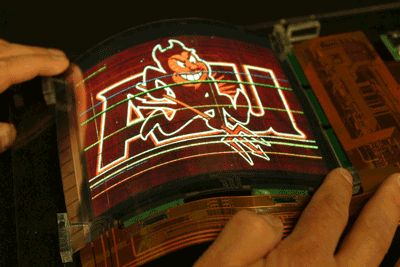World’s largest flexible OLED successfully manufactured
Meets targeted military goal of developing an effective, durable, cost-effective display
A group of researchers at Arizona State University’s Flexible Display Center, in conjunction with Army Research Labs scientists, have successfully manufactured the world’s largest flexible color organic light emitting display (OLED) prototype.

Researchers at Arizona State University have manufactured the world’s largest flexible OLED display (via: phys.org)
Using an advanced combination of mixed-oxide thin-film transistors, the team was able to create a working display model that measures 7.4 inches diagonally.
This meets a target set by the U.S. Department of Defense to develop a full-color, full-motion, flexible OLED video display for use in future military devices.
Manufacturing breakthrough
The team discovered that a unique combination of mixed oxide, thin film transistors offered the most cost-effective approach to manufacturing high-performance, super-flexible displays. Specifically, the fact that the transistors can be created on existing amorphous silicon production lines effectively eliminates the need for any sort of specialized equipment or processing techniques; this, in turn, reduces the overall cost to produce the device.
In terms of performance, the ASU’s flexible OLEDs provide the user with vibrant colors, high switching speeds between videos, and significantly reduced power consumption when compared to other similar models.
“This is a significant manufacturing breakthrough for flexible display technology,” said Nick Colaneri, director of the Flexible Display Center. “It provides a realistic path forward for the production of high-performance, flexible, full-color OLED displays, accelerating commercialization of the technology in the process.”
“One of the primary directives of the Flexible Display Center has been to pursue approaches to flexible technologies that take advantage of existing manufacturing processes,” continued Colaneri. “This focus drove us to pursue a flexible color display based on mixed-oxide TFTs, which are widely regarded as a strong, cost-effective alternative to low-temperature polysilicon. This display showcases the Center’s successful scale up to GEN II, and our ability to produce displays using mixed-oxide TFTs in standard process flows with our proprietary bond/de-bond technology.”
Are you in Boston today?
If so, swing by the Boston Convention and Exhibition Center. This new flexible OLED will be on display at the FDC booth (#643) as part of Society for Information Display Display Week, which runs June 5 to 7. ■
Story via: flexdisplay.asu.edu
Advertisement
Learn more about Electronic Products Magazine





